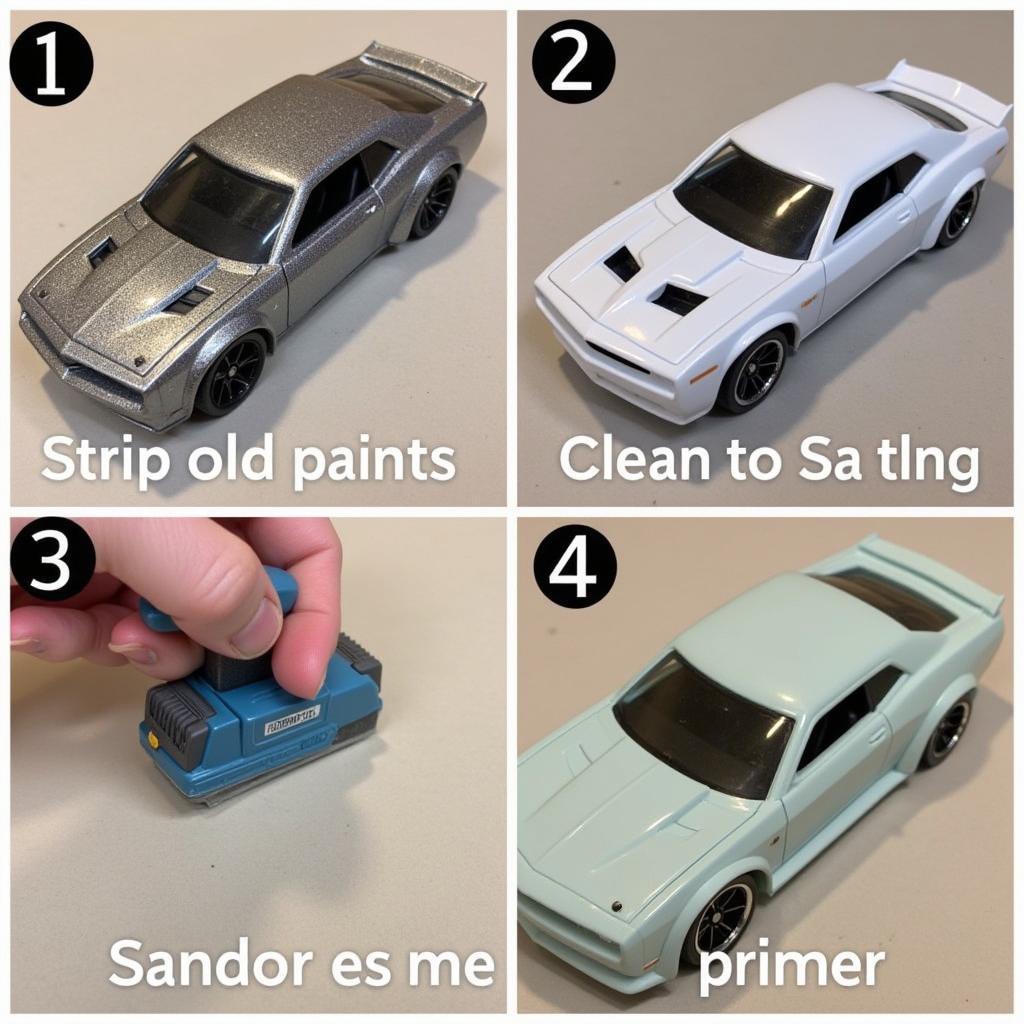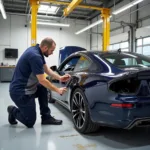Restoring your cherished Hot Wheels collection can be a rewarding experience, and a fresh coat of paint is often the key to revitalizing their miniature glory. Choosing the right paint for the job is crucial for a professional-looking finish. So, what kind of paint to repair Hot Wheels cars? Let’s dive into the world of miniature car restoration and explore the perfect paint options.
Choosing the Right Paint for Your Hot Wheels
Several factors influence the best paint type for your Hot Wheels restoration project. Consider the material of the car body (typically metal or plastic), the desired finish (glossy, matte, or metallic), and your budget. Acrylic paints are a popular choice for beginners due to their ease of use, quick drying time, and wide availability. Enamel paints provide a more durable and chip-resistant finish but require more care during application. For those seeking a factory-fresh look, specialized automotive paints like lacquer or urethane can offer exceptional results, but come with a higher price tag.
Types of Paint Suitable for Hot Wheels
- Acrylic Paints: Ideal for beginners, easy to clean up with water, and available in various colors and finishes.
- Enamel Paints: Offer a durable and chip-resistant finish, require proper ventilation due to strong fumes, and dry slower than acrylics.
- Lacquer Paints: Provide a smooth, high-gloss finish, often used for professional car restoration, and dry quickly.
- Urethane Paints: Extremely durable and resistant to chemicals and weathering, ideal for long-lasting restoration, but more complex to apply.
Preparing Your Hot Wheels for Painting
Before applying any paint, thorough preparation is essential for optimal adhesion and a flawless finish. Begin by stripping the original paint using a suitable paint remover designed for the car’s material. Thoroughly clean the car body with warm soapy water to remove any remaining residue or debris. Lightly sand the surface with fine-grit sandpaper to create a smooth and even base for the new paint to adhere to. Prime the car with a compatible primer to further enhance paint adhesion and create a uniform surface.
Essential Steps for Prepping Your Hot Wheels
- Strip the old paint: Use a quality paint remover and follow the manufacturer’s instructions.
- Clean the car body: Wash with warm soapy water and rinse thoroughly.
- Sand the surface: Use fine-grit sandpaper to create a smooth surface.
- Prime the car: Apply a thin, even coat of primer to enhance paint adhesion.
 Preparing a Hot Wheels Car for Painting
Preparing a Hot Wheels Car for Painting
Applying the Paint and Finishing Touches
Once the car is primed and ready, apply thin, even coats of paint, allowing each coat to dry completely before applying the next. Avoid applying thick coats, which can lead to drips and an uneven finish. For a professional-looking finish, consider using an airbrush or spray paint specifically designed for miniature models. After the final coat has dried, apply a clear coat to protect the paint and add a glossy sheen.
Tips for Achieving a Professional Finish
- Thin coats: Apply multiple thin coats for a smooth and even finish.
- Proper ventilation: Ensure adequate ventilation when using paints with strong fumes.
- Clear coat: Protect your paint job with a clear coat for added durability and shine.
“When restoring Hot Wheels, patience is key. Taking the time to properly prepare the car and apply thin, even coats of paint will ultimately result in a more professional and satisfying outcome,” advises Michael Diecast, a renowned miniature car restoration expert.
Conclusion
Knowing what kind of paint to repair Hot Wheels cars is crucial for achieving a professional-looking restoration. By selecting the appropriate paint type, preparing the car thoroughly, and applying the paint with care, you can restore your beloved Hot Wheels collection to their former glory. So, grab your favorite paints and brushes, and let the miniature car restoration begin!
FAQ
-
Can I use regular spray paint on Hot Wheels cars? While possible, using spray paint designed for miniature models is recommended for better control and a smoother finish.
-
What type of primer is best for Hot Wheels cars? A primer specifically designed for plastic or metal models is recommended, depending on the car’s material.
-
How long does it take for the paint to dry completely? Drying time varies depending on the paint type and environmental conditions, but typically ranges from a few hours to overnight.
-
How can I remove stubborn paint from a Hot Wheels car? Soaking the car in a suitable paint remover designed for the car’s material is usually effective.
-
What can I do if the paint drips or runs? Allow the paint to dry completely, then lightly sand the affected area and reapply a thin coat.
-
Where can I find specialized paints for Hot Wheels cars? Hobby shops, online retailers, and some art supply stores carry paints specifically designed for miniature models.
“Choosing the correct paint is the foundation of any successful Hot Wheels restoration. Consider the material of the car and the desired finish before making your selection,” adds Sarah Wheelwright, a leading authority on miniature car customization.
Looking for more tips and tricks on Hot Wheels restoration? Check out our other articles on car customization and model building.
Need personalized support? Contact us via WhatsApp: +1(641)206-8880 or Email: [email protected]. Our 24/7 customer support team is always ready to assist you.

